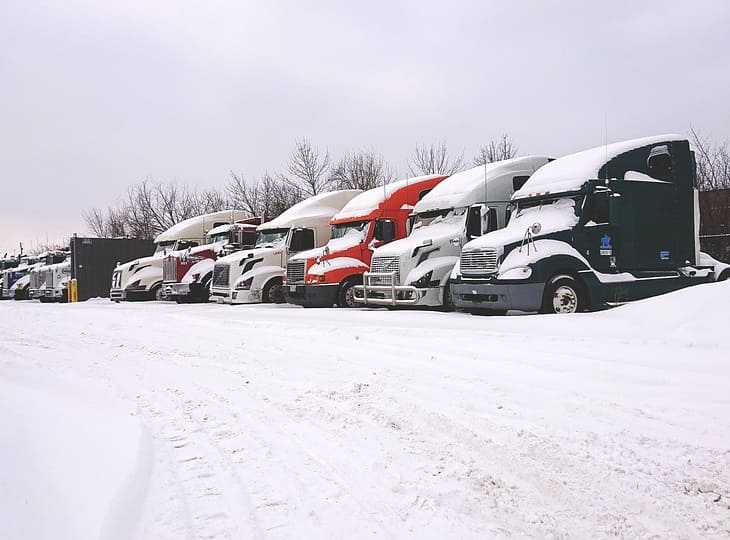Starting a truck in cold weather can be challenging. Cold temperatures affect your truck’s battery and engine.
But don’t worry, there are simple steps to help you get your truck started. Winter can be harsh on vehicles. Trucks, especially, can struggle to start in freezing conditions. Batteries lose power, and engines become sluggish. Knowing how to manage these issues is crucial.
With a few easy tips, you can ensure your truck starts smoothly even on the coldest mornings. This guide will help you understand the essentials for cold weather starting. From battery care to engine warming, we’ll cover everything you need. Get ready to learn how to keep your truck running, no matter how cold it gets outside.

Credit: www.drivebigtrucks.com
Preparation For Cold Weather
Ensure the battery is fully charged and in good condition. Use a block heater to warm the engine before starting. Check the oil and fuel levels, and use winter-grade fluids.
Getting your truck ready for the cold weather is like preparing for a marathon. You wouldn’t run without stretching first, right? The same goes for your truck. Cold temperatures can make your truck reluctant to start. Here’s how to ensure it’s ready to go when you are.Check Battery Health
Your battery is the heart of your truck. Cold weather can drain its power quickly. Make sure it’s in good shape. Inspect the battery terminals for any corrosion. Clean them if needed. Check the battery voltage with a multimeter. A fully charged battery should read about 12.6 volts. Anything lower, you might need a new battery. Remember, batteries tend to lose their charge faster in the cold. So, if your battery is more than a few years old, consider replacing it.Inspect Spark Plugs
Spark plugs are like the ignition for your engine. If they’re worn out, your truck might struggle to start. Look at the condition of your spark plugs. If they’re dirty or covered in carbon, clean or replace them. Check the gap between the spark plug electrodes. It should match the specifications in your truck’s manual. Having clean and properly gapped spark plugs ensures a good start every time. This is especially important in colder months. — Ever had your truck refuse to start on a cold morning? What steps did you take to fix it? Share your experience below!
Credit: www.rac.co.uk
Fuel System Considerations
Cold weather can make starting your truck a challenge. Your fuel system needs special attention during these months. Taking a few extra steps can ensure your truck starts smoothly. Here are some fuel system considerations to keep in mind.
Use Winter Fuel Additives
Winter fuel additives can help your diesel truck run better in the cold. These additives prevent fuel from gelling. They also improve fuel flow. Add the recommended amount to your fuel tank. This simple step can make a big difference.
Keep Fuel Tank Full
Keeping your fuel tank full in cold weather is important. A full tank reduces the chance of condensation. Water in the fuel can freeze and cause problems. Fill up often to prevent this. It also helps keep your fuel lines from freezing.
Engine Block Heaters
Engine block heaters keep the engine warm in cold weather. This helps trucks start easily in freezing temperatures. Simply plug in the heater before starting your truck.
Getting your truck started in cold weather can be a real challenge. One of the best ways to ensure a smooth start is by using an engine block heater. These devices warm up the engine block, making it easier for your truck to start, even in freezing temperatures. Let’s dive into the different types of engine heaters and some useful installation tips.Types Of Engine Heaters
There are various types of engine heaters available, each with its own benefits. Block heaters are the most common. They are typically installed in the engine block and use electricity to warm the coolant. Oil pan heaters attach to the bottom of the oil pan. They keep the engine oil warm and flowing smoothly, which is crucial in cold weather. Coolant heaters are another option. They heat the engine coolant directly and are often used in larger trucks or in extreme cold environments. Each type has its own installation method and requires different considerations.Installation Tips
Installing an engine heater can be straightforward if you follow some essential tips. First, make sure to read the manufacturer’s instructions. This might sound obvious, but skipping this step can lead to mistakes. Use the right tools. Having a good set of tools will make the installation process much easier. Don’t try to improvise with the wrong equipment. Check the heater’s compatibility with your truck model. Not all heaters fit all engines. Verify this before purchasing. Think about where you will plug it in. You’ll need a nearby electrical outlet. Make sure the cord is long enough to reach comfortably. Consider professional help if you’re unsure. A mechanic can install the heater quickly and ensure it’s done right. Have you ever struggled to start your truck on a cold morning? What steps did you take? Share your experiences and tips in the comments below. This might help someone else facing the same issue.Fluids And Lubricants
Starting your truck in cold weather can be challenging. Proper maintenance of fluids and lubricants can make a big difference. Ensuring your truck’s fluids are in good condition helps it perform efficiently during winter.
Cold Weather Oil
Cold weather oil is essential for your truck’s engine. Choose oil with a low viscosity rating. This helps it flow better in cold temperatures. Check the manufacturer’s recommendations for the best type. Using the correct oil can prevent engine wear. Regularly change the oil to keep the engine healthy.
Antifreeze Levels
Antifreeze levels are critical in winter. They prevent the engine from freezing. Check the antifreeze levels before the cold weather hits. Use a mixture of antifreeze and water as recommended. This ensures the coolant system works efficiently. Regularly check and top off the antifreeze to avoid engine damage.
Starting Techniques
Starting a truck in cold weather can be challenging. Knowing the right techniques is vital. Cold temperatures affect your truck’s battery, engine oil, and fuel system. These starting techniques can help you get your truck running smoothly.
Turn Off All Accessories
Before starting, turn off all accessories. This includes the radio, heater, and lights. These draw power from the battery. In cold weather, the battery needs all its power to start the engine. Turning off accessories reduces strain on the battery.
Cycle The Ignition
Cycle the ignition before fully starting the engine. Turn the key to the “on” position. Wait for the dashboard lights to turn off. This allows the fuel pump to prime the engine. Repeat this step two or three times. Then, start the engine. This technique helps in cold starts by ensuring fuel is ready.

Credit: logitydispatch.com
Battery Maintenance
Winter can be tough on your truck’s battery. Proper battery maintenance is crucial to ensure your truck starts smoothly in cold weather. By keeping your battery in good condition, you avoid the frustration of a dead battery on a freezing morning.
Clean Battery Terminals
Dirty battery terminals can lead to poor connections and starting issues. Regularly inspect your battery terminals for any build-up of corrosion.
If you notice a white or blueish substance, it’s time for a clean. Use a mix of baking soda and water with a wire brush to scrub away the corrosion. Rinse with cold water and dry thoroughly.
Keeping the terminals clean ensures a strong connection and reliable starts. Do you make a habit of checking your battery terminals?
Test Voltage Regularly
Testing your battery voltage can help you catch issues before they become serious. Use a voltmeter to check the battery’s charge.
A healthy truck battery should read around 12.6 volts when fully charged. If the voltage drops below 12.4 volts, your battery may be struggling to hold a charge.
Regular testing helps you stay ahead of potential problems. Have you tested your battery voltage lately?
By maintaining clean terminals and regularly testing your battery voltage, you can ensure your truck is ready to tackle cold weather without a hitch. Your proactive care can make all the difference during those chilly winter mornings.
Tire Care
Proper tire care is crucial for getting your truck started in cold weather. Ensuring your tires are ready for winter conditions can make a significant difference. Let’s dive into two essential aspects of tire care: maintaining proper tire pressure and considering winter tire options.
Proper Tire Pressure
Cold weather can cause tire pressure to drop. Low tire pressure can affect your truck’s handling and increase the risk of a flat tire. Check your tire pressure regularly, especially before heading out on a long drive.
Maintaining the correct tire pressure, as specified in your truck’s manual, ensures better traction on icy roads. It also helps with fuel efficiency. Investing in a good tire pressure gauge can make this task easier.
Have you ever noticed your truck’s performance decline during winter? This could be due to improper tire pressure. Regular checks can help you avoid unexpected issues and keep your truck running smoothly.
Winter Tire Options
Winter tires are designed to handle cold temperatures and slippery roads. They have deeper treads and softer rubber, which provides better grip. Swapping your regular tires for winter ones can significantly improve your truck’s safety and performance.
All-season tires might not be enough in severe winter conditions. Consider investing in a good set of winter tires if you often drive in snow or ice. They can be a game-changer in ensuring your truck starts and runs efficiently in cold weather.
Have you thought about the difference winter tires could make? If you haven’t tried them yet, you might be surprised at how much easier winter driving becomes. Proper tire care, especially in winter, is not just a precaution; it’s a necessity.
What steps will you take to ensure your truck’s tires are ready for the cold? Share your thoughts and experiences below!
Emergency Equipment
Cold weather can make starting your truck difficult. Having the right emergency equipment can save you a lot of trouble. Prepare for unexpected issues and keep your truck running smoothly. Below are two essential items you should always have.
Carry Jumper Cables
Jumper cables are a must-have for cold weather. They can help jump-start your battery when it fails. Make sure the cables are long and thick enough. Check the clamps for rust or damage. Keep them in an accessible place in your truck. This way, you can reach them quickly in an emergency.
Keep A Portable Charger
A portable charger is another vital item. It can charge your battery without another vehicle. Choose a charger that’s powerful enough for your truck. Test it regularly to ensure it works. Store it in a dry, safe location. This ensures it’s ready when you need it most.
Frequently Asked Questions
How To Start A Truck In Cold Weather?
Use a block heater to warm the engine. Check the battery and oil levels. Turn off all accessories. Start the truck and let it idle for a few minutes.
What To Do When A Truck Won’t Start In The Cold?
Check the battery and connections. Use a block heater or engine heater. Ensure fuel lines aren’t frozen. Use winter-grade fuel or additives.
Can It Be Too Cold For A Truck To Start?
Yes, extremely cold temperatures can prevent a truck from starting. Cold affects battery performance and thickens engine oil. Ensure proper winter maintenance.
Is It Possible For A Car Not To Start Because It’s Too Cold?
Yes, cold weather can prevent a car from starting. Low temperatures can affect the battery, fuel system, and engine oil.
Conclusion
Getting your truck started in cold weather can be a challenge. Follow the steps mentioned to ensure smooth starts. Check the battery, use the right oil, and warm up the engine. These tips will help maintain your truck in winter.
Stay prepared, and your vehicle will thank you. Happy driving!

